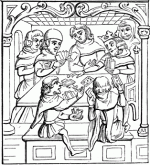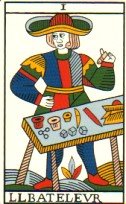Rosanne
Looking at the Noblet reproduction, The Bateleur card and its use of the number Three and reading about the Reformation, I wondered about an alternative view; the possibility of social commentary rather than a Salvation story (live well, trust in God, heaven is nigh). I broached the subject in a thread about Tarot and the Reformation/ The Pope's Monkey. Whether we call it High Middle Ages/early Renaissance is moot- because this time was governed by great material changes that started prior to Tarot, but at the start of Tarot's birth, Money was the driving force. Now the reproduction Noblet is c 1650, but you could assume correctly I think, that there were earlier decks, examples of which that we do not have today; excepting perhaps the Cary-Yale sheet c. early 1400's perhaps.
Two to One-It's lost and You Won't Get it Back! Medieval maxim.
Here's some words that you could apply in the times of Tarot's Birth.
Pledge (a security on property)
Mortgage (mort= dead, gage=Pledge)
Pawnbroker (lender of money on property/goods pledged; one year term legal)
Lending house(Church inspired bank)
Mont de Piete ( to get loans for the poor without interest)
Gaming House ( informal bank)
Lombard (historical term for pawn shops or moneychangers)
Cahors (a place)
Medieval trade fairs, contributed to the growth of banking in a curious way: moneychangers issued documents redeemable at other fairs, in exchange for hard currency. These documents could be cashed at another fair in a different country or at a future fair in the same location. If redeemable at a future date, they would often be discounted by an amount comparable to a rate of interest. Eventually, these documents evolved into bills of exchange, which could be redeemed at any office of the issuing banker. These bills made it possible to transfer large sums of money without the complications of hauling large chests of gold and hiring armed guards to protect the gold from thieves.(Wikipedia)
The growth of Italian banking in France was the start of the Lombard moneychangers in Europe, who moved from city to city along the busy pilgrim routes important for trade. One such place was Cahors. It was infamous at that time for having bankers that charged interest on their loans. The church in these times said that using money as an end in itself (usury) was a sin. Because of this Cahors became synonymous with this sin, and was mentioned in Dante's Inferno alongside Sodom as wicked.The term Lombard is synonymous with Cahorsin in medieval Europe, and means 'pawnbroker'. At the same time as the rise of Banking Preachers like Saint Bernadino were preaching against Gaming/gambling and exhorting the church to set up lending houses which would become very successful for the Church (because they charged interest and collected taxes) After 1400, political forces turned against the methods of the Italian free enterprise bankers -Not the Catholic lending houses. In 1401, King Martin I of Aragon expelled them. In 1403, Henry IV of England prohibited them from taking profits in any way in his kingdom. In 1409, Flanders imprisoned and then expelled Genoese bankers. In 1410, all Italian merchants were expelled from Paris. In 1401, the Bank of Barcelona was founded. In 1407, the Bank of St George was founded in Genoa. This bank dominated business in the Mediterranean. In 1403 charging interest on loans was ruled legal in Florence despite the traditional Christian prohibition of usury. Italian banks such as the Lombards, who had agents in the main economic centres of Europe, had been making charges for loans. The Lombards were Catholic, but did not have a cordial relationship with the Church, except in the relationship of money.
Take a long look at Card one- 'two to one' is shown clearly -two large tumblers, one small, the three circles associated with the Pawnbrokers symbol, but meant 'I the Banker ' and 'successful money transaction' - and the placement of the dice separated by the knife shape. The wand shapes on the table and one in the Hand.
So this card could depict the social commentary of the Moneychangers- the Lombard Man and a pun against the Lending houses set up by the Church when gambling houses were vilified and preached against.
In the black and white woodcut you can see the three pawnbroker balls by one player.
It seems to me that the story of salvation might not be the one shown in cards on the TdM style, rather social commentary of different sort- but the Visconti Magician looks like a Lombard Man too ~Rosanne
~Rosanne
Two to One-It's lost and You Won't Get it Back! Medieval maxim.
Here's some words that you could apply in the times of Tarot's Birth.
Pledge (a security on property)
Mortgage (mort= dead, gage=Pledge)
Pawnbroker (lender of money on property/goods pledged; one year term legal)
Lending house(Church inspired bank)
Mont de Piete ( to get loans for the poor without interest)
Gaming House ( informal bank)
Lombard (historical term for pawn shops or moneychangers)
Cahors (a place)
Medieval trade fairs, contributed to the growth of banking in a curious way: moneychangers issued documents redeemable at other fairs, in exchange for hard currency. These documents could be cashed at another fair in a different country or at a future fair in the same location. If redeemable at a future date, they would often be discounted by an amount comparable to a rate of interest. Eventually, these documents evolved into bills of exchange, which could be redeemed at any office of the issuing banker. These bills made it possible to transfer large sums of money without the complications of hauling large chests of gold and hiring armed guards to protect the gold from thieves.(Wikipedia)
The growth of Italian banking in France was the start of the Lombard moneychangers in Europe, who moved from city to city along the busy pilgrim routes important for trade. One such place was Cahors. It was infamous at that time for having bankers that charged interest on their loans. The church in these times said that using money as an end in itself (usury) was a sin. Because of this Cahors became synonymous with this sin, and was mentioned in Dante's Inferno alongside Sodom as wicked.The term Lombard is synonymous with Cahorsin in medieval Europe, and means 'pawnbroker'. At the same time as the rise of Banking Preachers like Saint Bernadino were preaching against Gaming/gambling and exhorting the church to set up lending houses which would become very successful for the Church (because they charged interest and collected taxes) After 1400, political forces turned against the methods of the Italian free enterprise bankers -Not the Catholic lending houses. In 1401, King Martin I of Aragon expelled them. In 1403, Henry IV of England prohibited them from taking profits in any way in his kingdom. In 1409, Flanders imprisoned and then expelled Genoese bankers. In 1410, all Italian merchants were expelled from Paris. In 1401, the Bank of Barcelona was founded. In 1407, the Bank of St George was founded in Genoa. This bank dominated business in the Mediterranean. In 1403 charging interest on loans was ruled legal in Florence despite the traditional Christian prohibition of usury. Italian banks such as the Lombards, who had agents in the main economic centres of Europe, had been making charges for loans. The Lombards were Catholic, but did not have a cordial relationship with the Church, except in the relationship of money.
Take a long look at Card one- 'two to one' is shown clearly -two large tumblers, one small, the three circles associated with the Pawnbrokers symbol, but meant 'I the Banker ' and 'successful money transaction' - and the placement of the dice separated by the knife shape. The wand shapes on the table and one in the Hand.
So this card could depict the social commentary of the Moneychangers- the Lombard Man and a pun against the Lending houses set up by the Church when gambling houses were vilified and preached against.
In the black and white woodcut you can see the three pawnbroker balls by one player.
It seems to me that the story of salvation might not be the one shown in cards on the TdM style, rather social commentary of different sort- but the Visconti Magician looks like a Lombard Man too



